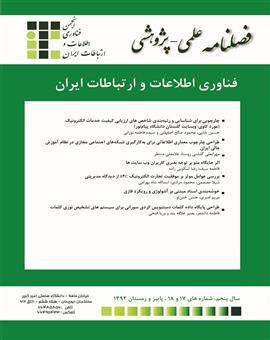چارچوبي براي شناسايي و رتبهبندي شاخصهای ارزيابي كيفيت خدمات الكترونيك(مورد كاوي: وب سايت گلستان دانشگاه پيامنور)
محورهای موضوعی :حسین بابایی 1 , محمود صالحاصفهانی 2 , سیده فاطمه نورانی 3
1 - کارمند
2 - دانشگاه جامع امام حسين (ع)
3 - دانشگاه پيام نور
کلید واژه: فناوري اطلاعات, كيفيت خدمات, رضايت مشتري, خدمات الكترونيك, وب سايت گلستان,
چکیده مقاله :
کیفیت خدمات مفهومی است که به دلیل مشکلات در تعریف و اندازهگیری آن، بحث های قابل توجّهی را در ادبیات تحقیق، بدون هیچ اتفاق نظر کلی، برانگیخته است. اغلب، رضایت مشتری و کیفیت خدمات با هم به عنوان توابعی از ادراک و انتظارات مشتری هستند و تحقیقات نشان داده است که کیفیت بالای خدمات، نقش مهمی در سودآوری دارد. هدف از این مطالعه، ارائة چارچوبي براي شناسايي و رتبه بندی شاخص هاي ارزيابي کیفیت خدمات است. نتایج مطالعه نشان داد که از نظر كاربران، همة شاخص هاي کیفیت خدمات مهم هستند. زمان واكنش، مهمترین شاخص در میان شاخص های دیگر است، بعد از آن اطمینان، كيفيت اطلاعات، سهولت استفاده، تعامل پذيري و طراحي به عنوان شاخص هاي مهم بعدي، نمره داده شدهاند. همچنين كاربران از قابليت اعتماد و كيفيت اطلاعات رضايت دارند اما از تعاملپذيري رضايت ندارند و ميزان رضايت كاربران از زمان واكنش، سهولت استفاده و طراحي در حدّ متوسطي است.
Service quality is a concept that, due to difficulties in defining and measuring the considerable debate in the literature, no general consensus, aroused. Often, customer satisfaction and service quality as a function of perceptions and customer expectations, and research has shown that the quality of the services plays an important role in its profitability. The purpose of this study is to provide a framework for identifying and ranking criteria for evaluating the quality of services. The results showed that, all parameters of quality of service are important. Response Time is an important indicator of the rest. The trustiness, informativeness, ease of use, empathy and visual appeal are next important factors. The users are satisfied with the trustiness and informativeness, but not with empathy. User satisfaction is medium with response time, ease of use and visual appeal.


